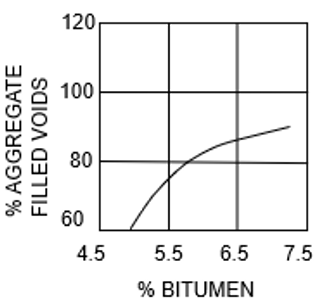This set of Pavement Design Problems focuses on “Highway Materials – Bituminous Paving Mixes – 2”.
1. What is the correction factor applied for a sample of thickness 63.5 cm in the Marshall mix design?
a) 0
b) 1.5
c) -1
d) 1
View Answer
Explanation: In order to conduct the stability test, the thickness of the sample should be 63.5 cm. Certain correction factors have to be applied if the thickness is not exactly 63.5 cm. The correction factors range from 0.86 to 1.19. If the thickness is 63.5 cm, then the correction factor to be applied is 1.
2. Workability depends on the type of aggregate used.
a) True
b) False
View Answer
Explanation: Workability is an important factor for the mix. It depends on the type of aggregates being used, their gradation, shape and texture also affect it. Generally, rounded aggregates improve the workability.
3. What is the correct formula for VFB?
a) \(\frac{100V_b}{VMA}\)
b) \(\frac{100V_v}{VMA}\)
c) \(\frac{V_b}{VMA}\)
d) \(\frac{V_v}{VMA}\)
View Answer
Explanation: VFB stands for voids filled with bitumen. It is expressed in terms of volume of bitumen and VMA. VFB represents the percentage of bitumen present in the voids in the mineral aggregate framework.
4. In the Hveem method what should be the desired limit of stabilometer value under light traffic?
a) < 30
b) > 35
c) > 30
d) < 35
View Answer
Explanation: The design criteria for each parameter has been set by Hveem. For light traffic, the stabilometer value should be > 30. Or medium traffic, it is > 35 and for heavy traffic, it is > 37.
5. As per the modified Hubbard-Field method, what is the criteria to find the optimum bitumen content?
a) 3-4% voids in total mix
b) 3-3.5% voids in total mix
c) 3-4% voids in aggregates
d) 3-3.5% voids in aggregates
View Answer
Explanation: The results obtained for various parameters are plotted in four different graphs. Parameter vs percentage bitumen is plotted. The optimum bitumen content is obtained from the % voids in total mix to % bitumen plot. The % bitumen corresponding to 3-3.5% voids in total mix gives the optimum bitumen content.
6. Which compaction device is used specifically in the Hveem mix design?
a) Vibro tamper
b) Rammer
c) Drop hammer
d) California kneading compactor
View Answer
Explanation: California kneading compactor is a machine that is used to provide compaction to the samples in the Hveem method. Vibro tamper is used to compact the soil in confined areas. Rammer is used in the lab for light compaction. Drop hammer is used in the Marshall method and hence is called the Marshall drop hammer.
7. What is the temperature range to which bitumen is heated in the Marshall mix design?
a) 175 – 190°C
b) 121 – 145°C
c) 154 – 160°C
d) 138 – 149°C
View Answer
Explanation: The temperature range for carrying out the operations to prepare the sample in the Marshall method is very important to ensure the desired mix. The aggregates and filler are heated to a temperature of 175 – 190°C, the binder is heated to a range of 121 – 145°C. The mixing process happens at the desired temperature range of 154 – 160°C. The compaction should be carried out in the range of 138 – 149°C.
8. In the initial Hubbard-Field method, the specimen was 2 inches in diameter and it was subjected to heavy compaction.
a) True
b) False
View Answer
Explanation: The Hubbard-Field method was modified to focus on bituminous mixes. The first method was used for the surface course and the sample was 2 inches in diameter and was hand compacted. In the modified method, the sample used is 6 inches one with heavy compaction.
9. Which method does the below plot belong to__________

a) Modified Hubbard-Field method
b) Marshall method
c) Hveem method
d) Hubbard-Field method
View Answer
Explanation: The above plot belongs to the Marshall method in which six different plots are made. In the modified Hubbard-Field method, there is a plot of % aggregate voids vs % bitumen. The shape of the graph is such that it resembles a sagging curve.
10. The specimen for the stabilometer test is placed inside a ______ membrane in order to apply ______
a) Rubber, vertical pressure
b) Polyurethane, vertical pressure
c) Rubber, fluid pressure
d) Polyurethane, fluid pressure
View Answer
Explanation: The specimen is enclosed in a rubber membrane which acts an inner wall of the mould. Through this rubber membrane, fluid pressure can be applied to the specimen. It is provided by rotating a handle. Vertical pressure is applied through a loading head.
11. The OBC corresponding to maximum stability, unit weight and 4% air voids are given as 5, 6 and 5.5. What is the OBC as per Marshall method?
a) 5.5
b) 5
c) 6
d) 16.5
View Answer
Explanation: As per the Marshall method, the OBC is found out as the average of the OBCs. So, the OBC would be \(\frac{5+6+5.5}{3}\)=5.5.
Sanfoundry Global Education & Learning Series – Pavement Design.
To practice all areas of Pavement Design Problems, here is complete set of 1000+ Multiple Choice Questions and Answers.
If you find a mistake in question / option / answer, kindly take a screenshot and email to [email protected]
- Practice Civil Engineering MCQs
- Check Pavement Analysis and Design Books
- Check Civil Engineering Books
- Apply for Civil Engineering Internship
